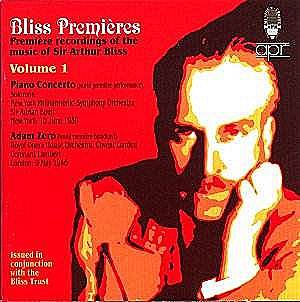Bryan Crimp’s renowned work in researching and making
available historic musical events for CD takes an impressive step
forward with this disc of the world premiere performance of Bliss’s
piano concerto. The original acetate disc recordings are in the
International Piano Archives at Maryland USA, repository of much
significant archival material relating to the instrument. Despite
unavoidable deterioration over the years it is possible to experience
once again the thrill of the occasion from the discs, and where
small parts went unrecorded (during the interchange between a pair
of turntables) patching has been used from Solomon’s 1943 recording
for HMV with Boult and the Royal Liverpool Philharmonic Orchestra.
The shellac recordings of movements from Adam Zero come from
the composer’s widow. Any hiss and crackle only adds to the flavour
of the historical context, so in this reviewer’s opinion, the transfers
are absolutely first-rate in both works and a tribute to Mr Crimp’s
labours of love. He has also written an excellent appreciation of
Solomon, called ‘Solo’, which I commend highly to the reader.
Bliss wrote the concerto to a commission from
the British Council in 1938 for performance at the British Week
of the New York World Fair in the summer of 1939. He had been
a juror the previous year on the Ysaÿe International Piano
Competition and came away highly impressed at the standard of
virtuosity of the competitors. Clearly this was still affecting
him when he wrote his concerto. It is an awesomely difficult work
neatly summarised by Nicolas Slominsky as ‘Lisztomorphic in its
sonorous virtuosity, Chopinoid in its chromatic lyricism, and
Rachmaninovistic in its chordal expansiveness’. Solomon’s playing
has unerring accuracy and confident abandon from the very start,
and it is hard to believe that Bliss had to give him a gentle
push on to the stage of a stiflingly hot Carnegie Hall because
he was too nervous to go on. Boult is a marvellously sympathetic
and supportive accompanist, and the orchestra play with a naturalness
which belies what must have been unfamiliarity with the Bliss
idiom. Later exponents of the concerto were Gina Bachauer, Trevor
Barnard, Noel Mewton-Wood and, nearer to our own day, John Ogdon
and Philip Fowke but it must have been a hard act to follow even
this baptismal performance by Solomon.
Adam Zero is the third of Bliss’s full-length
ballets (after Checkmate 1937 and Miracle in the Gorbals
1944), and in Wilfred Mellers’ view ‘the element of physical movement’
in the dance picks up with Bliss where Purcell left off … quite
a leap in time. Adam Zero is an allegorical comparison
between a man’s life and the four seasons from birth (Spring),
maturity and marriage (Summer), middle-age and mid-life crisis
(Autumn), to death (Winter). The immediate post-war years were
not propitious ones for such subject matter (it had only 19 performances
over two seasons whereas his two earlier ballets had 37 between
them). Also choreographer Robert Helpmann infused little traditional
choreography into the ballet (whose audiences are tough to please).
The composer suffered a considerable disappointment with the reception
of this work. Nevertheless, the music remains highly attractive
(especially the Night Club Scene), especially in the hands of
its dedicatee Constant Lambert. Lambert’s reputation as a conductor
has always been high but is further vindicated in this world premiere
broadcast of half the ballet (ten numbers). One can imagine listening
to the wireless on that Spring evening over half a century ago.
Christopher Fifield
Ian Lace adds:-
I endorse everything that Christopher Fifield
says about this performance. Solomon and The New York players
under Boult give an exciting, inspired performance of this tremendously
difficult work. The later Solomon wartime recording of this Concerto
with a Liverpool Philharmonic Orchestra comprising tired, ageing
payers (younger more vital performers had been called up for service)
is but a pale comparison. Playing devil’s advocate, I would not
go so far as to say, as Christopher does that the hiss and crackle
[and I would add, the sometimes furry, congested sound] on this
recording "adds flavour to the historical context."
I spoke to Bryan Crimp and he assured me he had done everything
he could to clean up the original acetate disc recordings but
the deterioration had been so severe that nothing further could
be done. I advise less patient listeners to persevere, for repeated
hearings only serve to confirm Bryan’s wise resolution to preserve
this extraordinarily powerful performance as a vital historic
document.
Equally important is the preservation of Constant
Lambert’s vibrant reading of Adam Zero in much better sound except
in ‘Dance with Death’. Lambert certainly knew a thing or two about
conducting music for dancing, music for the ballet!
Never mind the quality of the sound in the Concerto,
you will probably never hear more exciting accounts of these vibrant
and dramatic works.
Ian Lace
